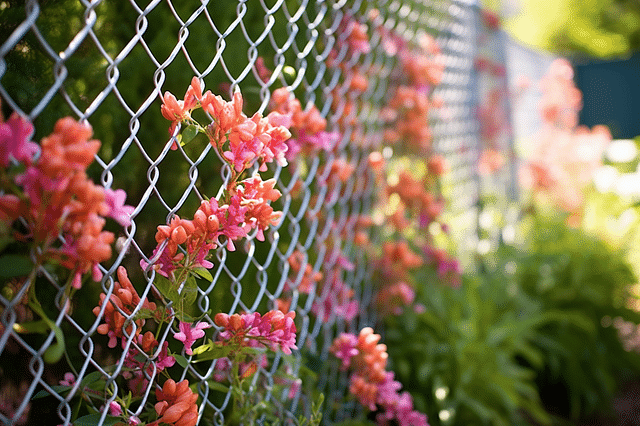How to easily remove a chain link fence
Discover the simple steps to remove a chain link fence effortlessly. Our latest blog post breaks it down for you, making it easier than ever. Read on to learn more!

Have you ever found yourself in a situation where you needed to remove a chain link fence but had no idea where to start? Perhaps you've recently moved into a new home and want to switch out that old, rusty fence for something fresher. Or maybe you're looking to expand your yard and the current fence is in the way. Whatever the reason may be, the thought of tackling this task can be overwhelming. But fear not! In this guide, we will walk you through the step-by-step process of easily removing a chain link fence, so you can take on this project with confidence. By the end, you'll be amazed by how simple and straightforward it can actually be. Let's get started!
Tools to get started
Removing a chain link fence requires a few basic tools that you may already have on hand. Here is a list of the tools you will need to successfully remove a chain link fence:
Work gloves: Protect your hands from sharp edges and potential injuries. Opt for sturdy work gloves that provide good grip and protection.
Safety goggles: Shield your eyes from any flying debris or loose materials that may be released during the removal process. Safety goggles are an important safety precaution.
Wire cutters: To start dismantling the chain link fence, you will need a pair of wire cutters. These are specially designed to cut through the wire mesh of the fence.
Pliers: Pliers will come in handy for gripping and removing any remaining wire staples or fasteners that hold the fence in place. They will provide the extra leverage needed for a clean removal.
Wrench or socket set: If your fence is secured with nuts and bolts, you will need a wrench or socket set to loosen and remove them. Make sure to have the appropriate sizes for the bolts used in your fence.
Pruning shears or bolt cutters: In some cases, you may encounter vegetation or overgrown plants that have intertwined with the fence. Pruning shears or bolt cutters will help you trim or cut through these obstacles.
Hammer: A hammer can be useful for knocking out any stubborn fence posts that are set in concrete. It will allow you to break up the concrete and loosen the post for easier removal.
Wheelbarrow or tarp: To keep the work area clean and organized, have a wheelbarrow or tarp nearby to collect and transport the removed fence materials.
Remember, it's always a good idea to wear appropriate clothing and footwear when working on a project like this. Closed-toe shoes, long pants, and a long-sleeved shirt are recommended to protect yourself from cuts and scratches. Additionally, ensure that you have a secure and stable ladder if you need to reach higher sections of the fence.
By having these tools on hand, you will be well-equipped to tackle the task of removing a chain link fence efficiently and safely.
Preparing for fence removal
Removing a fence may seem like a straightforward task, but it's important to take some necessary precautions to ensure a smooth and safe process. In this section, we'll cover some important steps to consider before tackling fence removal.
Should you notify your neighbors before removing the fence?
Before removing your fence, it's always a good idea to notify your neighbors. This simple gesture allows them the opportunity to prepare or make any necessary arrangements on their end. It also helps maintain positive relationships and avoid any potential disputes. Reach out to your neighbors, whether it's through a friendly chat, a note in their mailbox, or an email, and inform them of your plans to remove the fence. This small act of courtesy can go a long way in maintaining a peaceful neighborhood.
How to locate and mark any underground utilities?
Before you start removing your fence, it's essential to locate and mark any underground utilities that may be present in your yard. Underground utilities such as gas lines, water lines, or electrical cables can be hazardous if accidentally damaged. To avoid any accidents or interruptions in utility services, follow these steps to locate and mark these utilities:
- Contact your local utility companies: Reach out to the utility companies serving your area and request an underground utility mark-out. They will send technicians to mark the location of any utility lines on your property.
- Respect the markings: Once the utility lines are marked, familiarize yourself with the symbols used by the technicians. These markings indicate the presence of different utilities, such as gas, water, or electricity. Be careful not to disturb or remove these markings during the fence removal process.
- Dig safely: When digging near the fence posts or any marked utility lines, exercise caution. Use hand tools like a shovel or manual post hole digger instead of power tools to minimize the risk of accidentally damaging any underground utilities.
Taking the time to locate and mark underground utilities will help ensure the safety of both yourself and your property during the fence removal process.
How to secure any loose or protruding fence posts?
Before removing your fence, it's important to secure any loose or protruding fence posts to minimize the risk of accidents or injury. Here's how you can do it:
- Inspect the fence posts: Walk along the fence line and thoroughly inspect each post. Look for any signs of damage, rot, or loosened attachments.
- Reinforce loose posts: If you notice any posts that are loose but still in good condition, you can reinforce them to make them sturdier. Use metal brackets or braces to support the posts and secure them to the adjacent structures, such as the ground or an existing wall.
- Remove damaged posts: If you come across fence posts that are damaged beyond repair, it's best to remove them completely. This will prevent any potential hazards and make the removal process easier.
- Dispose of removed posts responsibly: Once you've removed any damaged or unnecessary fence posts, dispose of them responsibly. Check with your local waste management authorities for the proper disposal methods or recycling options.
Securing loose or protruding fence posts will not only ensure a safer fence removal process but also help maintain the overall integrity of your property.
Step-by-step guide to removing a chain link fence
Is your old chain link fence becoming an eyesore? Maybe it's time to give your outdoor space a fresh new look. Don't worry, removing a chain link fence doesn't have to be a daunting task. With a little patience and the right tools, you can easily take down that old fence and make way for something new. Here's a step-by-step guide to help you through the process.
Step 1: Unfastening the fence mesh
The first step in removing a chain link fence is to unfasten the fence mesh. Start by locating the tension bands that hold the mesh to the top rail and posts. Using a pair of pliers, carefully remove the tension bands, making sure not to damage the fence mesh in the process. Once the tension bands are removed, the mesh should easily come off the top rail and posts.
Step 2: Removing the top rail and posts
Once the fence mesh is removed, it's time to take down the top rail and posts. Start by removing any caps or fittings on the top rail. This can usually be done by simply unscrewing or popping them off. Next, locate the bolts or screws that hold the top rail to the posts. Use a wrench or screwdriver to loosen and remove them. Once the top rail is free, carefully slide it out of the posts. Finally, remove the bolts or screws that hold the posts to the ground. Depending on the location and condition of the posts, you may need to use additional tools or techniques to remove them.
Step 3: Dealing with concrete footings (if applicable)
If your chain link fence was installed with concrete footings, you'll need to deal with them before fully getting rid of the old fence. Start by digging around the footings to expose them. Once the footings are exposed, use a shovel or pry bar to loosen and break up the concrete. You may need to apply some force and use proper safety precautions, such as wearing gloves and safety glasses. Once the concrete is broken up into smaller pieces, remove them from the hole and dispose of them properly. Repeat this process for each concrete footing until they are all removed.
Step 4: Cleaning up and disposing of the fence
Congratulations! You have successfully removed your chain link fence. Now it's time to clean up and dispose of the old fence materials. Gather all the removed fence components, including the mesh, top rail, posts, and any other associated materials. Depending on your local regulations, you may need to dispose of them at a designated facility or bring them to a recycling center. Check with your local waste management authorities for specific guidelines on how to properly dispose of the fence materials.
By following these step-by-step instructions, you can safely and efficiently remove a chain link fence, opening up new possibilities for your outdoor space. Remember to work at your own pace and take proper safety precautions throughout the process.
Trending products
Shop outdoor accessoriesFrequently asked questions
- What tools do I need to remove a chain link fence?
- To easily remove a chain link fence, you will need tools such as a pair of pliers, a wrench, wire cutters, and a pry bar.
- Can I remove a chain link fence by myself or do I need help?
- While it is possible to remove a chain link fence by yourself, having someone to assist you can make the process quicker and easier, especially when dealing with larger sections.
- How do I start the process of removing a chain link fence?
- The first step is to remove any tension from the fence by loosening the tension bands and pulling out the fence fabric. From there, you can begin disconnecting the fence posts and removing them from the ground.
- Do I need to dig out the fence posts to remove them?
- Depending on the installation method, you may need to dig out the fence posts or simply detach them from the concrete footing. Check the installation method of your fence to determine the best approach.
- What should I do with the old chain link fence material?
- You have a few options for disposing of the old chain link fence material. You can recycle it, repurpose it for other projects, or contact a local waste management facility for proper disposal.
- Are there any safety precautions I should take when removing a chain link fence?
- It is important to wear protective gloves and goggles to prevent any injuries while removing a chain link fence. Additionally, be cautious of sharp edges and secure loose sections of the fence to avoid accidents.
- Can I reuse the chain link fence material once it's removed?
- Yes, you can reuse the chain link fence material for various purposes, such as creating a pet enclosure, constructing a trellis, or even as a barrier for garden plants.
- How long does it usually take to remove a chain link fence?
- The time it takes to remove a chain link fence depends on various factors, including the size of the fence and the complexity of the installation. On average, it can take a few hours to a full day to complete the removal process.
- Will removing a chain link fence damage my yard?
- While there may be some minimal disruption to the ground during the removal process, it is unlikely to cause significant damage to your yard. However, it's always a good idea to take precautions to protect delicate landscaping or surfaces.
- Are there any alternative methods for removing a chain link fence?
- If you're not comfortable removing the fence yourself, you can hire a professional fence removal service who will have the necessary tools and expertise to handle the job efficiently.
Are you looking for more ideas?
Have a look at these other guides about improving your garden and patio to create your dream outdoor space!

Are you looking for more ideas?
-
- Role
- How Long Does Patio Sealer Take To Dry?
- Description
- Discover the drying time for patio sealer and how long it takes for your patio to be ready for use. Find out the best tips to minimize drying time and ensure a long-lasting, beautiful outdoor space.
-
- Role
- Update Your Fence: Paint vs. Stain - Pros and Cons Explained
- Description
- Paint or stain? Discover the pros and cons of updating your fence. Make an informed decision with our in-depth analysis.
-
- Role
- How to stretch chain link fence for maximum durability
- Description
- Discover the ultimate guide to stretching chain link fences for maximum durability. Enhance the functionality and appeal of your property with our expert tips. Don't miss out on our valuable updates!
-
- Role
- How to cut a chain link fence with ease
- Description
- Looking to cut a chain link fence effortlessly? This blog post has all the tips and tricks you need. Don't miss out, read on now!



